| |
|
|
47.
| The Blackboard 01 |
| |

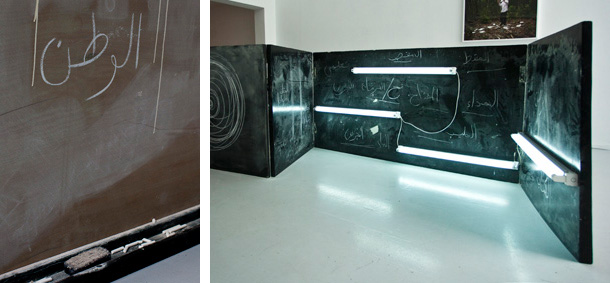
The Blackboard, 2013, 377 x 96 x 152 cm, blackboards, chalks, brushes, luminescent tubes.
Exhibition view of Darkning Process, MMP+, 2016, Marrakech.
Courtesy of the artist and Ceysson & Bénétière, Paris.
Ed. of 1 + 1 A.P.
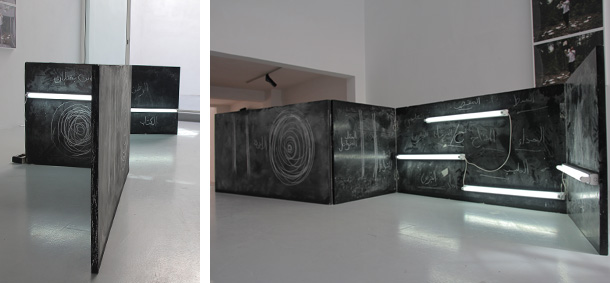
The Blackboard, 2013, 377 x 96 x 152 cm, blackboards, chalks, brushes, luminescent tubes.
Exhibition view of Darkning Process, MMP+, 2016, Marrakech.
Courtesy of the artist and Ceysson & Bénétière, Paris.
Ed. of 1 + 1 A.P.
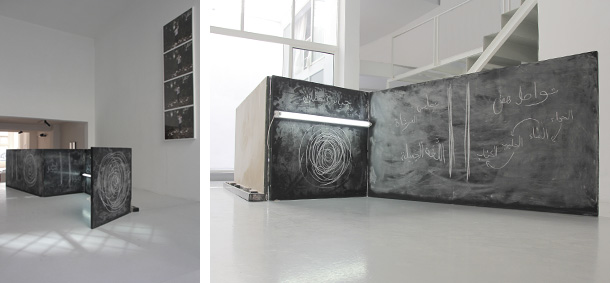
The Blackboard, 2013, 377 x 96 x 152 cm, blackboards, chalks, brushes, luminescent tubes.
Exhibition view of Darkning Process, MMP+, 2016, Marrakech.
Courtesy of the artist and Ceysson & Bénétière, Paris.
Ed. of 1 + 1 A.P.
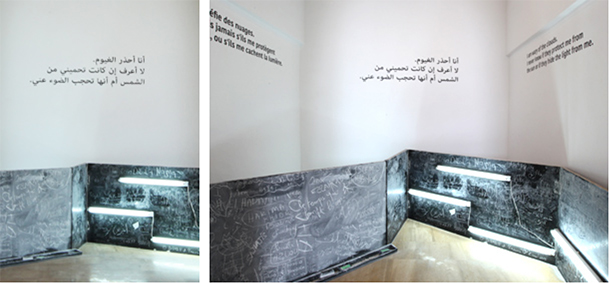
The Blackboard, 2013, 377 x 96 x 152 cm, blackboards, chalks, brushes, luminescent tubes.
Exhibition view of Darkning Process, MMP+, 2016, Marrakech.
Courtesy of the artist and Ceysson & Bénétière, Paris.
Ed. of 1 + 1 A.P.
With The Blackboard, mounir fatmi questions our relationship to education by offering experimentation and observing its effects on the individual.
Studio Fatmi, February 2017
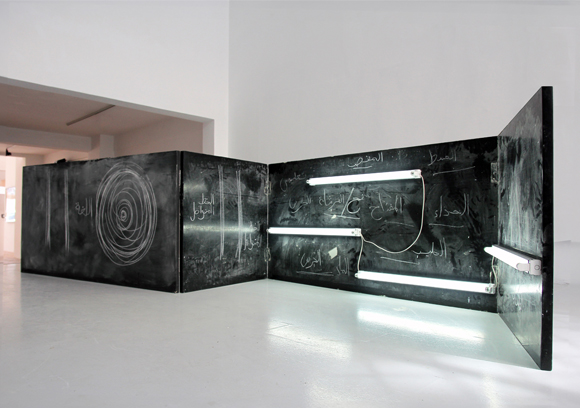
The Blackboard 01
Exhibition view of Darkning Process, MMP+, 2016, Marrakech.
Courtesy of the artist.
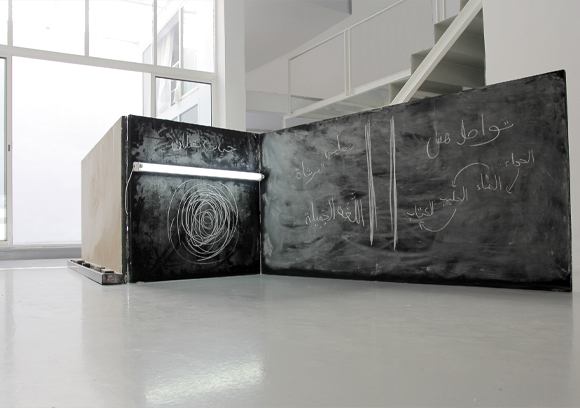
The Blackboard 01
Exhibition view of Darkning Process, MMP+, 2016, Marrakech.
Courtesy of the artist.
|
|
|
|
|
| Collection of MOCA, The Museum of Contemporary Art, Los Angeles
|
Le Tableau Noir, œuvre ouverte et participative, invite le spectateur à se frayer un chemin le long d'une structure labyrinthique qui semble issue de ses fantasmes enfantins. L'installation se compose d'une série de tableaux de salle de classe noirs - espace limité des exercices scolaires imposés - qui compartimentent strictement l'espace d'exposition. La surface des panneaux est jalonnée de longs tubes fluorescents émettant une vive lumière blanche. Plus loin, surgissent deux motifs récurrents et vaguement inquiétants, tracés dans un geste manifestement répétitif et plein de hargne : une ligne droite et une spirale irrégulière. Sur le mur une citation extraite du Manifeste de Mounir Fatmi sonne comme une mise en garde, un avertissement : "Je me méfie des nuages. Je ne sais jamais s'ils me protègent du soleil ou s'ils me cachent la lumière".
Avec Le Tableau Noir Mounir Fatmi interroge notre rapport à l'éducation en donnant à expérimenter et à observer ses effets sur l'individu. "Beautiful Language", vidéo réalisée en 2010 explorait déjà les relations entre éducation et langage. La vidéo utilisant des images de "l'Enfant sauvage" (1970) de Truffaut mettait en scène l'enfant traçant des cercles rageurs alors que le docteur tente de lui enseigner comment faire une ligne droite. L'installation donnait à observer la lutte qui s'opère entre ce qu'il y a de "sauvage" dans l'individu, d'indéterminé et ce qui relève de la culture et de la civilisation. Elle mettait en évidence la violence exercée par le processus d'éducation et d'acquisition du langage et des savoirs. Le Tableau Noir pose à présent la question de l'attitude à observer, de la stratégie à tenir, face aux connaissances et aux systèmes de production et de transmission des connaissances. Ces éléments de civilisation sont-ils bons ou néfastes pour moi, constituent-ils une aide dans ma perception du monde ou contribuent-ils à ma cécité intellectuelle? Est-il simplement possible d'avoir la moindre distance critique vis-à-vis d'éléments profondément constitutifs de mon être?
Pour répondre à ces questions, Le Tableau Noir invite le spectateur à se faire acteur et l'oblige à se déplacer pour alterner vues d'ensemble et partielles de l'œuvre, à régler la distance d'observation en fonction des éclairages et de leur lumière qui éblouit autant qu'elle donne à voir, et à employer craies blanches et éponges afin d'y apporter ses propres modifications. Les panneaux se couvrent peu à peu d'inscriptions en différentes langues et de traces d'effacements successifs, comme d'autant de mandalas ou de palimpsestes éphémères. L'objet de répression éducative est appelé à se transformer en espace de création et de recréation. Une fois révélé le rôle ambivalent de l'éducation, du langage et de la culture dans notre perception du monde - ce qui permet de voir et en même temps ce qui aveugle - Le Tableau Noir invite à surmonter l'obstacle et propose une stratégie du déplacement, de la participation et du partage.
Studio Fatmi, février 2017.
|
|
The Blackboard, an open and participative work, invites viewers to make their way through a labyrinthine structure that seems to have manifested from their childhood fantasies. The installation is composed of a series of classroom blackboards - a space that was limited to imposed school exercises - that strictly compartmentalized the exhibition space. The surface of the two panels is interspersed with long fluorescent tubes emitting a bright white light. Further on, two recurring and vaguely disturbing motifs emerge, rendered in a clearly repetitive and harsh gesture. A straight line and an irregular spiral. On the wall, a quote from Mounir Fatmi’s Manifesto sounds like a warning: “I am wary of the clouds. I never know if they are protecting me from the sun or if they are hiding the light from me.”
With The Blackboard, Mounir Fatmi questions our relationship to education by offering experimentation and observing its effects on the individual. “Beautiful Language,” a video made in 2010, already explored the relationship between education and language. The video used images from Truffaut’s “Wild Child” (1970) that feature a child drawing angry circles while the doctor tries to teach him how to draw a straight line. The setup allowed us to observe the struggle between an individual’s “wild,” indeterminate nature, and aspects taken from culture and civilization. It highlighted the violence of the education, language and knowledge acquisition processes. The Blackboard now raises the question of which attitude should be observed, and which strategy should be followed in terms of knowledge and the ways in which is it produced and transmitted. Are these elements of civilization good or harmful to me, do they offer help in the way that I perceive the world or do they contribute to my intellectual blindness? It is even possible to have the slightest critical distance from elements deeply constitutive of my being?
To answer these questions, The Blackboard invites the spectator to become a participant and obliges him or her to move in order to alternate the view of all parts of the piece, to adjust the distance of observation in correlation to the lighting that dazzles as much as it permits one to see, and to use white chalk and sponges to add one’s own contributions. The panels gradually become covered in inscriptions in different languages, traces of successive erasures, and mandalas as well as fleeting palimpsests. An object used for educational repression is destined to become a space of creation and recreation. Once the ambivalent role of education, language, and culture is revealed in the way we see the world, which allows us to see as much as it blinds us, The Blackboard invites us to overcome the obstacle as it proposes a way to reposition, participate, and share.
Studio Fatmi February 2017.
Traduit du français par Christina Washington.
|
|
|
|